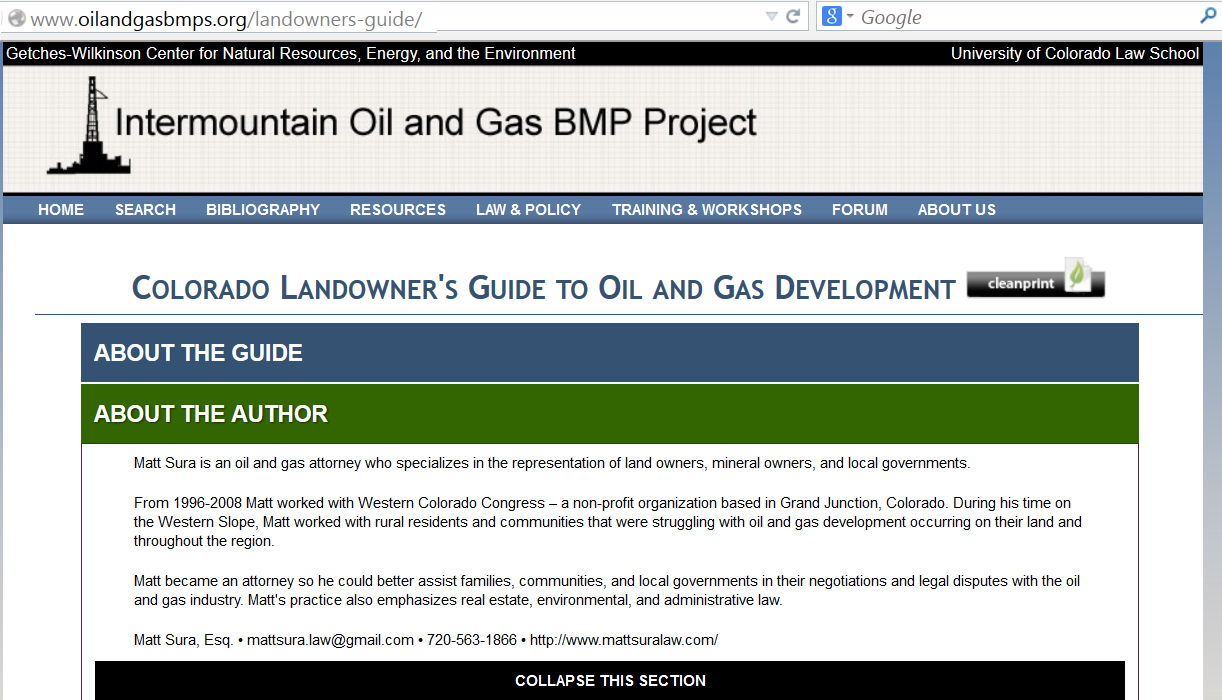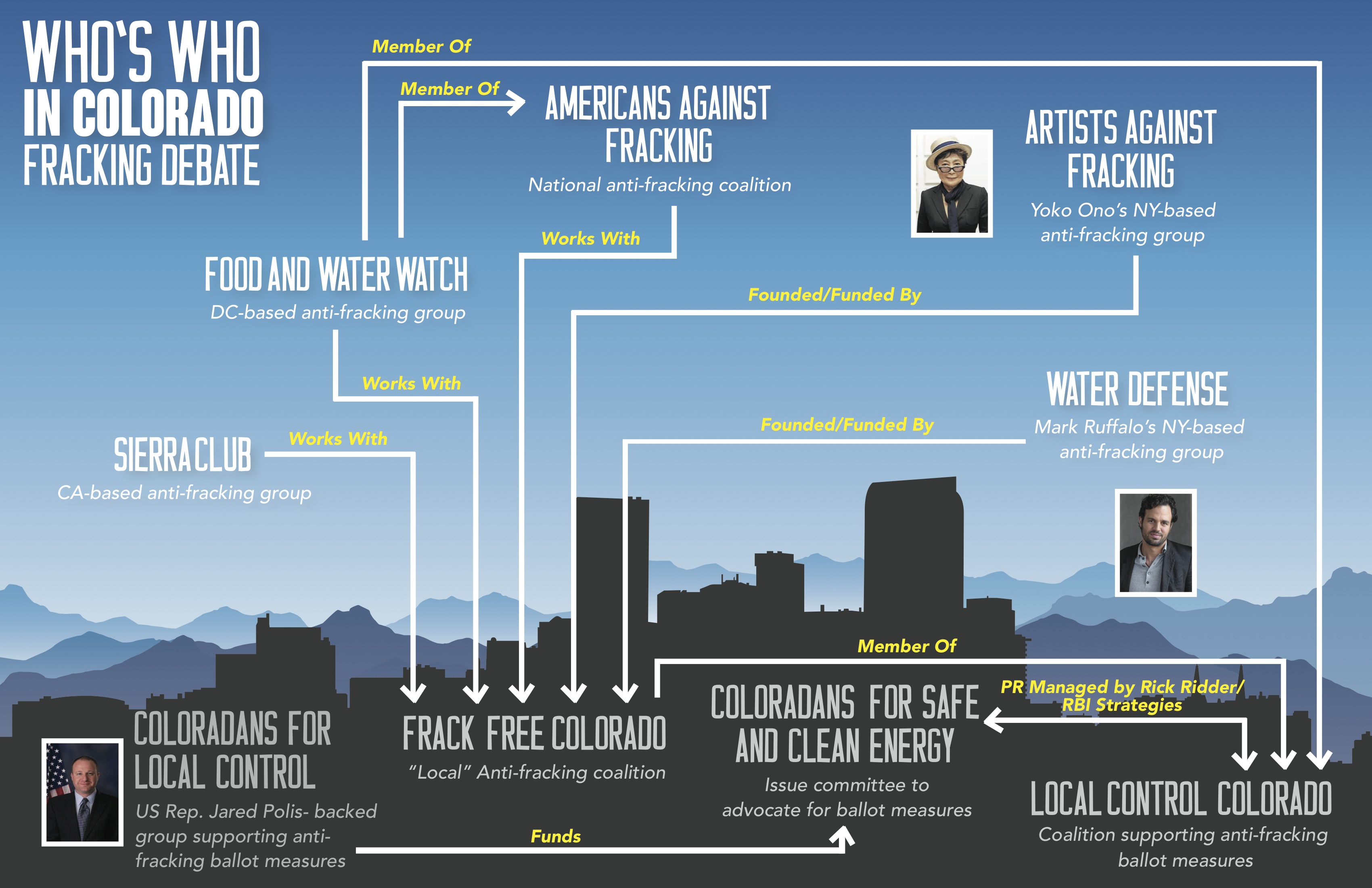Elbert County endorses “fractivist” lawyer
From: The Campaign Goes On: ‘Ban Fracking’ Groups Target New Colorado Task Force
“An activist lawyer
For 12 years – from 1996 to 2008 – Boulder attorney Matt Sura worked for the WCC as a community organizer and, ultimately, the group’s executive director. Now in private practice, Sura has applied for a seat on the new oil and gas task force, and says he’s no longer an anti-energy activist. In March, Sura told The Colorado Observer: “[F]ar from being a fracktivist, I actually work on oil and gas development.”
Sura’s work came under close scrutiny when he was hired by local officials in Brighton, Colo., to help update the city’s oil and gas regulations. He then advised the city to impose a temporary drilling ban. The ban was overturned less than a month later after Brighton residents – many of whom work in the oil and gas industry – learned of Sura’s background in anti-energy activism.
Besides working for the WCC for more than a decade, Sura collaborated with activist groups during last year’s local “ban fracking” campaigns in Northern Colorado. He helped organize an event titled “Tools for Activism on Oil and Gas Development,” which was co-hosted by Frack Free Colorado, Food & Water Watch and several other anti-energy groups. And in November 2013, National Journal reported that Sura was working with activists in Greeley who wanted to impose a moratorium on drilling projects inside the city limits.”
http://www.elbertcounty-co.gov/current_county_permit_applications.php#.VAIu1GP4RzU
http://www.oilandgasbmps.org/landowners-guide/
Could Elbert County’s inability to get Agave to perform thus far on all of the elements specified in the standard MOU + Schedule A have something to do with this? Has Elbert County’s CDS gone down another primrose path of over zealous regulation that effectively precludes – or interminably delays – O&G development?
low bidders
see you in the funny papers Colorado
Stewie sings about local control amendments, fracking, Polis, Udall, Steyer, and the Guv’na
Big Green Radicals
From: Big Green
“Colorado is ground zero for the fracking debate. That’s why national environmental groups are turning their attention and their checkbooks to the state, trying to gin up support for several anti-fracking ballot initiatives that would advance their radical agendas. But rather than being up front about their support and agendas, these groups are resorting to deceptive practices to trick Colorado voters into siding with them.
For example, knowing that its radical agenda would be unpalatable to Coloradans, big green’s out-of-state agitators founded the “local” group Frack Free Colorado (FFC). In addition to receiving generous support from out of state funders, FFC shared Water Defense’s Manhattan-based press secretary Ana Tinsely up until last year. And FFC’s leader, Russell Mendell, worked for Water Defense as recently as 2012 and didn’t even move to Colorado until that year.
That’s not to say that FFC doesn’t work hard to maintain the fiction that it’s a grassroots group. Following Water Defense’s bragging about the role it played in helping to pass several Colorado fracking bans in 2013, FFC deleted all mentions of Water Defense from its website. FFC also keeps quiet about its other outside Colorado founding members, including Food & Water Watch, Fractivist.com (run by a Sierra Club operative), and Patagonia, a California clothier. Unfortunately for big green’s agenda, Coloradans know the difference between grassroots and astroturf.
Big green groups are also deceptively using the Trojan Horse strategy to advance their radical agenda. Rather than present their true motivations – a complete ban on responsible energy development – they advance the notion of mere “local control.” (Surely they have been told that this doesn’t sound as radical to Coloradans, who – as poll after poll shows – overwhelmingly favor responsible energy development.) Of course, local control is anything but: City, county, or statewide bans violate one’s local property rights, the sanctity upon which Colorado and the country was founded.
This is a dangerous game that big green is playing. As its deceptive practices are exposed, it risks real backlash from Colorado voters, who hate deceptive groups pretending to be from Colorado even more than they hate outside groups themselves.”
Project Veritas stings anti-frackers
carts before horses
In his book The Deliberate Corruption of Climate Science, Tim Ball, Phd, reported that on July 5th, 2005, Phil Jones, Directer of the CRU [Climate Research Unit of the University of East Anglia], wrote in an email to a colleague;
“If anything, I would like to see the climate change happen, so the science could be proved right, regardless of the consequences. This isn’t being political it is being selfish.”
Therefore, climate change is an unproven hypothesis – an experiment waiting for corroborating data. Mr. Jones is too generous in calling this science. This is a belief system.
Let your mind imagine an estimate of the opportunity costs incurred the world over from all of the unproven hypotheticals that have been translated into public policy without any corroborating evidence. Imagine what could have been done with all those resources, all those man-hours, and all that energy, had the work been available to accomplish necessary objectives, rather than hyped-up political fantasies. Imagine all of the real problem solutions foregone while men chased rainbows.
A man can only do so much in a lifetime. We should cull out the unproven hypotheticals from our public policies, no matter how sexy they sound. Translation – government has no business getting involved with 90% of what it attempts to do.
Hydraulic Fracturing 101
debunks the fracking aquifer risk myth
Studies: ‘Not Physically Plausible’ for HF to Pollute Water
2:02pm EST August 8, 2013
 by Dana Bohan
by Dana Bohandana@energyindepth.org, Washington, D.C.
Last year, Dr. Tom Myers released a report suggesting it was theoretically possible for hydraulic fracturing fluids to migrate vertically through thousands of feet of solid rock to contaminate water aquifers — within as little as three years’ time. As you might remember, the study, which was funded by the anti-fracking group Catskill Mountainkeeper, received a strong rebuke from the scientific community. As Energy In Depth has highlighted before, a report released in May from the Pennsylvania Geological Survey (PGS) and Pennsylvania Council of Professional Geologists (PCPG) found Dr. Myers’ assumptions were “unsupported by any empirical data,” among other problems. That same month, the research firm Gradient released a report analyzing potential exposure pathways for hydraulic fracturing fluids, including upward migration from the shale formation itself. According their report:
“[T]here is no scientific basis for significant upward migration of HF fluid or brine from tight target formations in sedimentary basins.”
Gradient recently published another paper, this one featured in the National Ground Water Association’s periodical Groundwater, which reiterates that Myers’ theory is basically impossible:
“Our review of the literature indicates that HF affects a very limited portion of the entire thickness of the overlying bedrock and therefore, is unable to create direct hydraulic communication between black shales and shallow aquifers via induced fractures. As a result, upward migration of HF fluid and brine is controlled by preexisting hydraulic gradients and bedrock permeability. We show that in cases where there is an upward gradient, permeability is low, upward flow rates are low, and mean travel times are long [often >1,000,000 years]. Consequently, the recently proposed rapid upward migration of brine and HF fluid, predicted to occur as a result of increased HF activity, does not appear to be physically plausible. Unrealistically high estimates of upward flow are the result of invalid assumptions about HF and the hydrogeology of sedimentary basins.” (p. 1)
“Our analysis and literature review indicate that where upward flow occurs, both permeability and flow rates are low, and therefore, timescales for transport are long. Overall, the rapid upward migration scenarios that have been recently suggested (Rozell and Reaven 2012; Myers 2012; Warner et al. 2012) are not physically plausible.” (p. 9)
As the authors point out, the geological characteristics of basins in which shale formations exist are not conducive to the upward migration of hydraulic fracturing fluids. For starters, the formations above these shales are typically of low permeability — including siltstones, mudstones, and shales. Secondly, hydraulic fracturing not only impacts a small portion of the rock, but the pressures associated with the process are “short lived and localized to the fracture network.”
A second peer-reviewed paper from Gradient, featured in the journal Geophysical Research Letters, echoed these findings. The study concluded:
“It is not physically plausible for induced fractures to create a hydraulic connection between deep black shale and other tight formations to overlying potable aquifers, based on the limited amount of height growth at depth and the rotation of the least principal stress to the vertical direction at shallow depths. Therefore, direct hydraulic communication between tight formations and shallow groundwater via induced fractures and faults (e.g., as suggested by Myers [2012], Rozell and Reaven [2012], and Warner et al. [2012]) is not a realistic expectation based on the limitations on fracture height growth and potential fault slip.” (p. 4)
These reports, completed with funding from Halliburton, are two more in a growing library of scientific literature that shows hydraulic fracturing does not pose a credible threat to groundwater resources. That fact has been reiterated by state and federal regulators, scientific experts, and industry engineers time and time again. So, while groups opposed to shale development hang on to the talking point that hydraulic fracturing is a threat to subsurface water supplies, the facts – and the studies — continue to prove them wrong.
Fracking Outrage Management
Fracking Risk Communication
by Peter M. Sandman
This paper by Peter Sandman breaks down the message mechanics of both the pro and anti fracking interests. By doing so Sandman outlines a paradigm whereby we can navigate – manage – the confrontations and polarized rhetoric heard in Elbert Country for the past 3 years, and impacted communities all over the world.
It is most refreshing to discover that the terms of the debate are not limited by, or adequately defined by, the extremists – and that solution vectors exist that can satisfy all stakeholders.
fracking frenzies
Longmont Is Ground Zero In War Over Fracking
By Vincent Carroll
The Denver Post
10/17/2012
If you haven’t seen the video of anti-fracking protesters hectoring Gov. John Hickenlooper in Longmont last month and then thrusting signs against his car, you should Google it to get an idea of the passion behind the movement — here and nationally — to outlaw hydraulic fracturing for oil and natural gas. [Read more…]
Left protect tyrants money source
The Global Plot Vs. U.S. Fracking
Investors.com Posted 10/03/2012 06:39 PM ET
Geopolitics: What do Hugo Chavez, Vladimir Putin, Gulf oil sheiks and President Obama have in common? They all want to halt the U.S. energy revolution in fracking. No wonder so many of them are endorsing Obama. [Read more…]
reality intrudes into art
Update:
Matt Damon’s Anti-Fracking Movie Financed by Oil-Rich Arab Nation
“It is therefore of particular note that it is financed in part by the royal family of the oil-rich United Arab Emirates.”
For his next escape
Matt Damon’s troubled anti-frack film
By PHELIM MCALEER
Last Updated: 12:23 AM, September 26, 2012
Posted: 10:24 PM, September 25, 2012
Matt Damon and John Krasinski ran into a big problem while making their film “Promised Land”; how they solved it tells us a lot about Hollywood.
Some time ago, the two actors decided to make a movie about fracking — a method of getting once-inaccessible oil and gas out of the ground that has become the bête noire of many environmentalists.
The two wrote a screenplay they said was about “American identity . . . and what defines us as a country.”
It was the usual Hollywood script. We all know the . . . drill: Damon’s character works for an “evil” oil company. He comes to small-town America and sells locals a dangerous bill of goods.
Then he encounters two problems — his corporate heart is melted by an attractive local woman and Krasinki’s character, an environmentalist, reveals the oil company plan to exploit, pollute and leave.
Shocked townspeople feel betrayed. Damon is conflicted — will he go with the company and his career, or with his heart and ride back into town in his white SUV, denounce the oil company and save the day?
The filmmakers were so pleased with the script that they announced it would be promoted as a potential Oscar winner.
But then came trouble. [Read more…]




